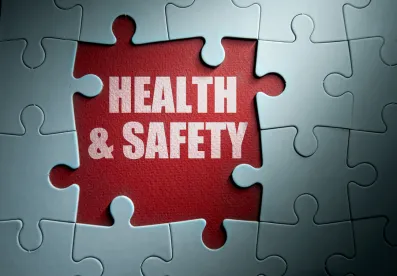On January 29, 2021, the Occupational Safety and Health Administration (OSHA) published “Protecting Workers: Guidance on Mitigating and Preventing the Spread of COVID-19 in the Workplace.” The Guidance incorporates much of the existing guidance from the Centers for Disease Control and Prevention (CDC), adds to guidance OSHA previously issued, and reflects strategies and practices familiar to many employers.
The Guidance, which is intended for non-healthcare employers, is not mandatory and does not have the same legal effect as an OSHA standard. Nevertheless, it provides insight into OSHA’s views and previews what the agency may include in an Emergency Temporary Standard (ETS), which the Biden administration has directed OSHA to consider and potentially implement by March 15, 2021.
OSHA’s Guidance provides all employers an important opportunity to review their COVID-19 prevention strategies. While most of the Guidance is not new, it provides a handful of new recommendations employers may want to consider adding to their current COVID-19 protocols. The new recommendations include:
-
Establish a system to communicate and provide training to all employees on the employer’s COVID-19 policies and establish an avenue for employees to report COVID-19-related concerns anonymously, without fear of retaliation. All such communications should be in languages employees understand and provided in a manner accessible to individuals with disabilities.
-
Make COVID-19 vaccines available at no cost to all eligible employees and provide information and training on the benefits and safety of vaccinations. While OSHA does not specify the information or training it suggests employers provide, the Guidance references CDC’s “Frequently Asked Questions About COVID-19 Vaccination.”
-
Don’t distinguish between workers who are vaccinated and those who are not. All vaccinated employees should continue to wear a mask, socially distance, and follow other COVID-19 protocols (e.g., exclusion from the workplace following COVID-19 exposure). This is necessary because, as OSHA explains, at this time, “there is not evidence that COVID-19 vaccines prevent transmission of the virus from person-to-person.”
-
Provide all workers with face coverings (i.e., cloth face coverings and surgical masks), unless their work task requires a respirator, at no cost.
OSHA recommends that employers provide all workers with face coverings, which include cloth face coverings and surgical masks, for use in the workplace with limited exception and unless their work tasks require a respirator (such as an N95 filtering facepiece respirator) or would present a hazard. OSHA also recommends that employers consider acquiring masks with clear coverings over the mouth for all workers to facilitate lip-reading for employees who are deaf or have a hearing deficit. OSHA further recommends that employers require all other individuals at the workplace over the age of two, such as visitors or customers, to wear face coverings. Where employees with disabilities cannot wear a certain type of face covering, employers should discuss the possibility of providing a reasonable accommodation using an interactive process. OSHA’s Guidance on reasonable accommodations for face covering requirements dovetails with guidance on reasonable accommodations previously provided by the Equal Employment Opportunity Commission (EEOC).
OSHA has explained in previous guidance that cloth face coverings are not personal protective equipment (PPE), but can be used as recommended by CDC as a preventive measure in an employer’s COVID-19 exposure control plan. The new Guidance acknowledges that cloth face coverings can reduce exposure for the person wearing the covering in some instances.
The rest of the Guidance reviews additional practices and protocols that OSHA suggests are necessary for an effective COVID-19 prevention program. These are as follows:
-
Assign a coordinator. OSHA recommends assigning a workplace coordinator to be responsible for COVID-19 issues. The coordinator should administer the COVID-19 prevention program on the employer’s behalf.
-
Conduct a hazard assessment. It is important for employers to identify where and how workers may be exposed to COVID-19 and implement responsive COVID-19 hazard controls. As OSHA points out, it is important to consult with employees, especially those who are in the trenches, when conducting the assessment to understand the realities of the workplace.
-
Identify a combination of measures that will prevent and limit the spread of COVID-19. OSHA provides a hierarchy of controls, prioritizing engineering controls that eliminate the COVID-19 hazard entirely, followed by administrative policies and PPE to protect workers from COVID-19 hazards. OSHA lists several commonly recognized measures that employers should take and provides details to assist employers to implement these measures effectively:
-
Separate and send home infected or potentially infected people from the workplace.
-
The first step in any workplace safety hazard assessment is to eliminate the hazard. In the case of COVID-19, that means removing infected or potentially infected people from the workplace. We recommend that employers communicate clear expectations to employees and adopt employee and visitor screening practices consistent with state and local requirements and recommendations.
OSHA incorporates existing CDC guidance on how long individuals who are infected should isolate and how long workers who have been exposed to COVID-19 through a close contact with a known infected individual should be excluded from the workplace and directed to quarantine. Workers who have COVID-19 should isolate until they meet the CDC guidelines, or applicable state and local health department requirements, to end isolation (at a minimum, 10 days).
As for workers who are exposed to COVID-19, CDC continues to endorse that these individuals should quarantine for 14 days. CDC explains that any quarantine shorter than 14 days balances reduced burden against a small possibility of spreading the virus. With that balancing act in mind, CDC recognizes that local public health departments may adopt shortened quarantine options if the exposed individual is asymptomatic; for example, ending quarantine after day 10 without testing, or 7 days after receiving a negative test result (test must occur on day 5 or later). CDC advises that in limited circumstances, employers may consider allowing critical infrastructure workers to continue working following exposure.
OSHA explains that most employers will follow a symptom-based strategy for identifying, separating, and sending workers home. OSHA also recognizes that there are some circumstances where “employers may consider a COVID-19 test-based strategy.”
-
Implement physical distancing in all communal work areas.
OSHA explains that the “best way to protect individuals is to stay far enough away so as not to breathe in particles produced by an infected person.” Keeping 6 feet of distance is generally recommended, but it is “not a guarantee of safety, especially in enclosed spaces or those with poor ventilation.” To increase physical distance, it is often important to limit the number of people in one place at any given time and increase physical space between people. OSHA recommends numerous strategies that many employers have adopted over the past 10 months, including telework, flexible work hours, staggered shifts, delivery of remote services, limiting the size of meetings, and using visible cues to encouraging distancing, to name a few.
-
Install barriers where physical distancing cannot be maintained. OSHA recommends installing transparent shields or other solid barriers at fixed workstations where workers cannot maintain 6 feet from other people.
-
Suppress the spread of COVID-19 by using face coverings to prevent COVID-19-infected individuals from spreading the virus through respiratory droplets when they speak, sneeze, or cough.
-
Improve ventilation. OSHA directs employers to the CDC’s guidance on ways to optimize ventilation following the American Society of Heating, Refrigerating and Air-Conditioning Engineers (ASHRAE) “Guidance for Building Operations During the COVID-19 Pandemic.” The OSHA Guidance also details steps employers should take to evaluate their ventilation systems and, where needed, increase air filtration to prevent the spread of COVID-19. In addition to generally increasing ventilation rates, employers are encouraged to improve central air filtration by having a MERV-13 filter (the grade of filter recommended by ASHRAE) or the highest filter compatible installed on the system. The Guidance further recommends that employers ensure ventilation systems are functioning properly, well maintained, and regularly cleaned and serviced.
-
Use applicable PPE to protect workers from exposure. When other measures cannot be implemented or do not protect workers fully, the Guidance concludes that current OSHA standards require that employers provide PPE as a supplement to other controls. (As discussed above, OSHA maintains that cloth face coverings are not PPE.) The standards referenced in the Guidance include OSHA’s PPE and respiratory protection standards, 29 CFR 1910, Subpart I, which require employers, at a minimum, complete a written hazard assessment to determine the need for PPE and PPE appropriate for the hazard and corresponding procedures and training. Therefore, employers are responsible for determining when and what PPE is necessary to protect workers while in the workplace. If an employer determines that an employee must wear PPE while at work and to perform a job safely, the PPE should be provided at no cost to workers and maintained in a safe condition. In application to COVID-19, CDC has addressed when PPE is necessary for job tasks that require interactions with individuals known or suspected of having COVID-19 and, depending on the task, recommends PPE consisting of surgical masks or respirators, such as the filtering facepiece respirators (e.g., N95) or personal air purifying respirators (PAPRs), with eye and face protection (i.e., face shields), protective gowns, and gloves.
If workers are required to use respirators to protect against COVID-19 exposures, employers should comply with the existing respirator standard which requires, among other things, that employers have (i) a written respirator program, (ii) a documented hazard assessment showing the selection of respirator for the hazard, (iii) ensured employees who must use respirators are medically evaluated, fit tested, and trained on their use, maintenance, and care before use, and (iv) implemented procedures to guarantee respirators are used, stored, and, where appropriate, disposed of safely. Many of these requirements must be completed annually.
Although the obligations for an employer are reduced, employers have similar compliance obligations when employees are permitted to use respirators voluntarily. These requirements include ensuring the use of respirators will not create a hazard, which generally requires a hazard assessment, written program detailing conditions of voluntary use, steps to prevent employees from wearing respirators improperly, and measures to ensure employer-provided respirators are properly stored, maintained, and disposed. An employer also must provide employees a copy of the respiratory standard’s Appendix D, which advises employees to consult with their physician on the appropriateness of respirator use. Therefore, employers must be prepared to comply with certain provisions of the PPE and respirator standard if allowing employees to use respirators in the workplace to protect against COVID-19.
There are times when PPE is not required under OSHA standards or other industry-specific guidance but may be provided as a reasonable accommodation under the Americans with Disabilities Act (ADA). Other workers may want to use different or additional PPE voluntarily due to concerns over their personal safety or the safety of a family member who is at higher risk for severe illness. The public dialogue about respirators has increased in recent weeks given the identification of the new virus variants and decisions of leaders in some European countries to require N95s, or similar medical-grade respirators, in many public spaces. Employers should be prepared for some employees to elect to use N95 respirators, double masks, or other equipment at work. In those cases, OSHA recommends that employers encourage and support the employees’ voluntary use of PPE. In doing so, however, employers should comply with applicable federal and state standards, including OSHA’s standards on PPE use, and ensure that employees’ voluntary use of PPE does not pose an additional workplace hazard.
-
Provide supplies for good hygiene, including access to soap and water and hand sanitizer, and take other steps to promote hand washing and respiratory etiquette.
-
Perform routine cleaning and disinfecting. OSHA summarizes and directs employers to follow existing CDC guidance on cleaning and disinfection measures. OSHA’s Guidance also reminds employers that workers may need PPE during disinfecting based on the setting and product used. Employers also may need to comply with federal and state standards and regulations governing use, storage, and disposal of hazardous chemicals, such as OSHA’s Hazard Communication Standard.
-
Consider protections for workers at higher risk for severe illness. Workers with disabilities may be entitled
to “reasonable accommodations” under state and federal law to protect them from the risk of contracting COVID-19. The EEOC discusses reasonable accommodations that could offer protection to an employee who is at higher personal risk from COVID-19 due to a pre-existing disability in D.1 of its “What You Should Know About COVID-19 and the ADA and Rehabilitation Act.” OSHA encourages employers to consider whether workers who have an increased personal risk of contracting a severe respiratory illness from COVID-19 (including older adults and anyone who has a serious medical condition) can do some or all of their work at home or in a less densely occupied, better ventilated workplace.
-
Establish a system for communicating effectively with workers. Employers should ask workers to report, without fear of reprisal, symptoms of COVID-19, possible COVID-19 exposures, and possible COVID-19 hazards at work. Similarly, employers should establish channels for communicating important information to employees and, of course, communicate with workers in a language they understand.
-
Educate and train workers on COVID-19 policies and procedures. OSHA recommends that, along with training workers on company policies, employers educate workers about the basic facts about COVID-19, including how it is spread. This can go a long way to helping workers understand why proper distancing, appropriate face coverings, and other measures are important to protect them. OSHA outlines a number of other topics that should be included in worker and supervisor training. OSHA recommends that the training be in plain language that workers understand (including non-English languages and American Sign Language or other accessible communication methods, if applicable).
-
Instruct workers who are infected or potentially infected to stay home and isolate or quarantine. OSHA recommends attendance policies that are non-punitive.
-
Minimize the negative impact of quarantine and isolation on workers. OSHA recommends that, “when possible,” employers allow workers to telework, use paid sick leave, if available, or consider implementing paid leave. Employers that were covered under the Families First Coronavirus Response Act (FFCRA), generally employers with less than 500 employees, can still take advantage of tax credits in connection with voluntarily providing paid leave for COVID-19 related reasons through March 31, 2021.
-
Isolate and send home workers who show symptoms at work.
-
Perform enhanced cleaning and disinfection after people suspected or confirmed to have COVID-19 have been in the workplace. Employers should follow CDC’s guidance, which includes increasing air circulation, cleaning, and disinfection using an EPA-registered disinfectant identified for use against SARS-CoV-2, the virus that causes COVID-19. Employers are required to comply with existing OSHA standards, including those related to hazard communication and PPE appropriate for exposure to cleaning chemicals.
-
Provide guidance on screening and testing. Employers should follow state and local guidance for screening and viral testing (as distinguished from antibody testing) in workplaces. Employers that adopt workplace testing programs should inform workers of testing requirements. We recommend employers review recent guidance from the CDC placing a new emphasis on informed consent prior to testing.
-
Record and report COVID-19 infections and deaths as required by existing OSHA regulations. Employers must record work-related cases of COVID-19 illness on their Form 300 Logs if certain criteria are met. An employer has an obligation to record an employee’s COVID-19 illness if: the exposure is work-related, it results in a fatality, lost workdays, job restrictions or transfers, or otherwise requires medical treatment beyond first aid. Employers must report to OSHA a COVID-19 illness if an employee is admitted to the in-patient service of a hospital within 24 hours of a workplace exposure to COVID-19 or if an employee dies within 30 days of a workplace exposure to COVID-19. In the case of a hospitalization, an employer has 24 hours to report to OSHA from when the in-patient hospitalization occurs or when the employer learns of the hospitalization if the latter occurs later. In the case of a fatality, the employer must report a work-related COVID-19 death within 8 hours of the death or within 8 hours of learning of the employee’s death, if the death occurred within 30 days of the workplace exposure. These are fact-driven, often complicated, analyses and not every employee who tests positive for COVID-19 needs to be recorded on an employer’s OSHA 300 Log or reported to OSHA, for that matter.
-
Implement protections from retaliation and set up an anonymous process for workers to report COVID-19-related hazards. OSHA explains that the Occupational Safety and Health Act prohibits employers from discriminating against an employee for raising “a reasonable concern about infection control related to COVID-19.”
-
Comply with existing OSHA standards. OSHA reminds employers that all OSHA standards that apply to protecting workers from infection, including requirements for PPE, respiratory protection, sanitation, protection from bloodborne pathogens, and requirements for employees to access medical and exposure records, remain in place. As mentioned above, while there is no OSHA standard specific to COVID-19, employers still have an obligation under the General Duty Clause to “provide a safe and healthful workplace that is free from recognized hazards that can cause serious physical harm or death.”
Next Steps
Employers should consider the following next steps:
-
Review your COVID-19 prevention program and consider adopting additional elements to align with OSHA recommendations.
-
Train employees, including supervisors, on your latest COVID-19-related policies and prevention strategies.
-
Evaluate availability of vaccines in your state and locality, strategize for making vaccines available to employees, and develop your employee communication strategy.
-
Continue to monitor new and evolving guidance and requirements from OSHA, the CDC, and the EEOC, as well as state and localities where your workplaces are located.
The year 2020 highlighted the need for all of us to be agile, adjusting and responding as our world shifted, science evolved, and best practices for responding to COVID-19 developed and changed. This year is shaping up in a similar manner.
Mary L. Bradley also contributed to this article.








 />i
/>i

